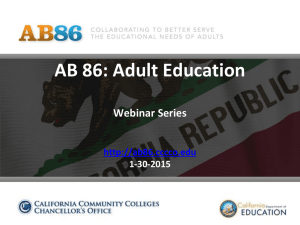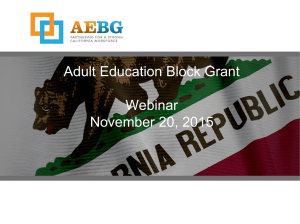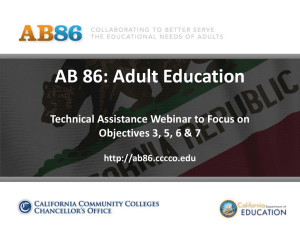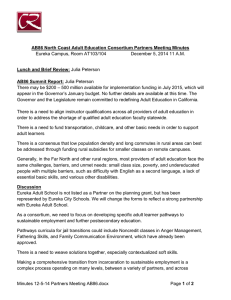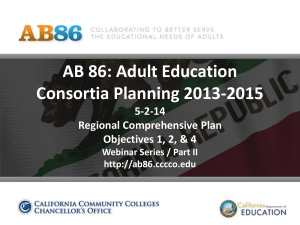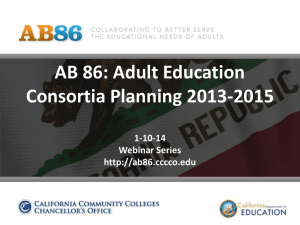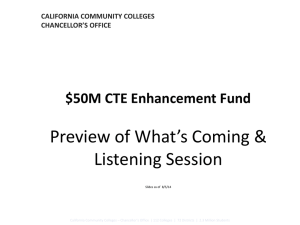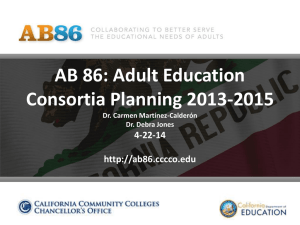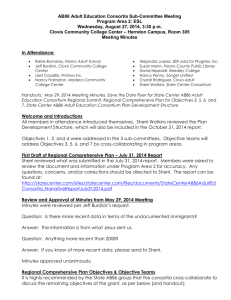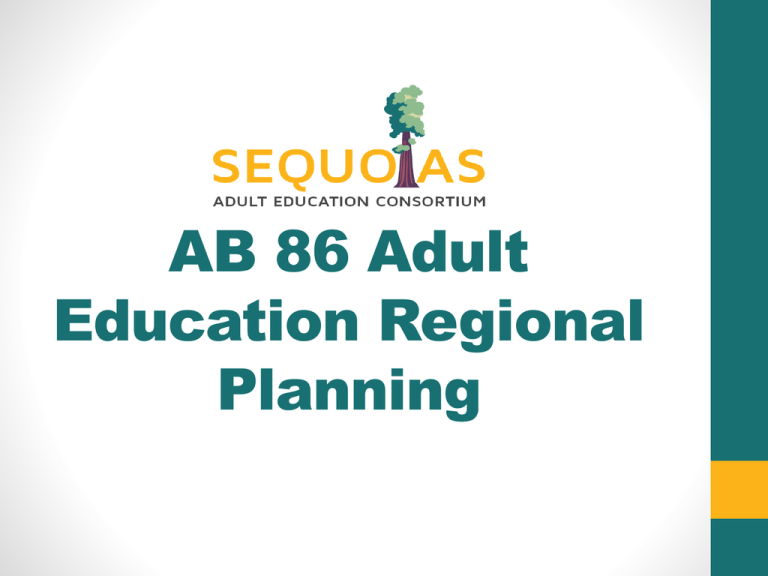
AB 86 Adult
Education Regional
Planning
What is AB86 ?
$25 Million Statewide for Planning
AB 86, Section 76, Article 3
The purpose is develop regional plans to better serve
the educational needs of adults in:
1. Elementary and basic skills; classes required for HSD or
equivalency certificate
2. Classes for immigrants: ESL, citizenship, and workforce
preparation
3. Programs for adults with disabilities
4. Short term CTE programs with high employment potential;
5. Programs for apprentices
2
AB 86, Section 76, Article 3
• Each Adult Education Consortium plan must include at a
minimum:
• An evaluation of current level and types of adult
education programs within its region including
education for adults in correctional facilities, credit,
noncredit and enhanced noncredit adult education
coursework and programs funding through Title II of
the federal Workforce Investment Act
• An evaluation of current needs for adult education
programs within its region
• Plans for parties that make up the Adult Education
Consortia to integrate their existing programs and
create seamless transitions into postsecondary
education or the workforce
AB 86, Section 76, Article 3
• Each Adult Education Consortium plan must include at a
minimum:
• Plans to address the gaps identified
• Plans to employ approaches proven to accelerate a
student’s progress toward his or her academics or
career goals
• Plans to collaborate in the provision of ongoing
professional development opportunities for faculty and
other staff to help them achieve greater program
integration and improve student outcomes
• Plans to leverage existing regional structures
AB 86, Section 76, Article 3
• It is the intent of the Legislature to work toward
developing common policies related to adult
education affecting adult schools at local
educational agencies and community colleges
including policies on fees and funding levels.
• It is the intent of the Legislature to provide additional
funding in the 2015-2016 fiscal year to the regional
consortia to expand and improve adult education.
State Implementation
• Cabinet:
• 3 Vice Chancellors from the Community College
Chancellor’s Office
• 3 Division Directors from the California Department of
Education
• Work Group
• 2 Members from the Community College Chancellor’s
Office
• 2 Members from California Department of Education
• 4 Members appointed from Adult Education programs
around the state
• 4 Members appoints from Community Colleges
Regional Planning
Process
• Regions: the geographic area made up by each
community college district.
• Members: the community college district and school
districts located within the geographic boundaries of
the community college district
• 70 Regional Consortia across the state
• 72 Community College Districts and 315 School
Districts are participating
Key Definitions
• A consortium consists of at least one school district and
at least one community college district within the
geographical boundaries of the community college
district.
• A region is defined as the geographical boundaries of a
community college district.
• 70 Regional Consortia across the state
• A member is defined as a public school district or
community college district within the geographical
boundaries of the designated region.
• 72 Community College Districts and 315 School
Districts are participating
• A partner is determined by the local consortium’s
membership.
Regional Planning
Timeline
• December 2013: A Certification of Eligibility was
released
• January 2014: Cover Sheet was Due
• February 2014: Intent to Participate forms and Project
Management Plan Due
• July 2014: Progress Report Due
• October 2014: Progress Report Due
• December 2014: Draft Regional Comprehensive Plan
Due
• March 2014: Final Regional Comprehensive Plan Due
Legislative Report
The AB86 Work Group
released a Legislative
report describing the
planning process in
April.
The report is available
at ab86.cccco.edu
AB86 Myths and Facts
• Myth: The Community Colleges will be taking over adult
education and adult schools will be close.
• Fact: AB 86 is about collaboration between the
Community Colleges and Adult Schools. The purpose of
the planning grants is to bring together the strengths of
both systems in order to better serve the educational
needs of adults in California.
• Myth: AB86 means that all community colleges are
directed to have non-credit adult ed programs.
• Fact: AB 86 does not require all community colleges to
have non-credit adult ed programs. However, even if
colleges offer only credit programs, they are vital to
effective regional planning and are encouraged to
participate in regional consortia. AB 86 specifically lists
credit programs as a part of the regional planning
process.
Coordination and
Collaboration
• We don’t know what next year will look
like or what Adult Education will look
like
• We have been tasked with planning to
better collaborate and coordinate our
two systems to better serve the
educational needs of adults in our
region

